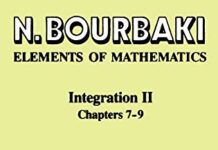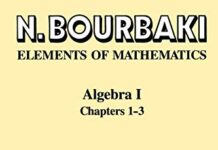
Ebook Info
- Published: 2004
- Number of pages:
- Format: PDF
- File Size: 35.30 MB
- Authors: N. Bourbaki
Description
This is a softcover reprint of the English translation of 1968 of N. Bourbaki’s, Théorie des Ensembles (1970).
User’s Reviews
Reviews from Amazon users which were colected at the time this book was published on the website:
⭐It seems like theres enough information here (and elsewhere) about the Bourbaki series in general so I wont comment on that. This review is written for someone that wants to learn set theory and is written with an eye to the other options available.The Bad:1) No Comparisons – This book constructs one system of axioms for set theory. There is no comparison of this theory with other theories, nor is there any in depth analysis of the axioms and thier interrealtion. You would find this stuff in most other introductory set theory books, but not here.2) Light Exposition – Set theory and mathematical logic are subjects where results are subtle, and you need to tease out these subtleties by constantly thinking about the theorems. This book, unlike other set theory books, doesnt point out these subtle things and so the burden is left to the reader. (It is a huge burden for the unintiated!)3) Typographical Errors – There are a few typographical errors. Some of these are obvious, some are not; the ones that are not obvious are devastating, since a proof will become incomprehensible with a few misplaced symbols.4) Proofs Are Condensed – The proofs offered are written very concisely. There is very little in the proof to help the reader follow along and as such you need to think a bit about what is going on.The Good:1) Great System – The particular system of axioms used is rather standard so it wont be unfamiliar. What is especially great is that they go so in depth with the background logic; they actually use part of the logical system and the axioms of set theory to prove the axiom of choice.2) Rigour – The book is incredibly rigorous. Everything is done with great precision without being long winded.3) Generality – Theorems are proved in the most general form possible. This is incredibly good if you are interested in using the theorems in many other branches of mathematics. Its also interesting to see exactly how general theorems can get.4) Structures – This book, unlike other set theory books, focuses heavily on creating mathematical structures from set theoretical objects. If you plan to persue model theory then this is a godsend.I would not recommend this book to someone who has not already had an aquiantance with axiomatic set theory. I would not recommend this book to anyone that likes to solve mathematical problems: the focus here is on theory and not problem solving. Finally i would not recommend this book to anyone that has even the slightest trouble following rigorous mathematical proofs.This is a unique book that should be read by good mathematicians after an introduction to set theory; especially if they plan to persue model theory or (obviously) the rest of the Bourbaki series.Readingbefore this book is more than adequate. Readingbefore or afterwards will make up for the shortcomings of this book.Many mathematicians very much dislike the Bourbaki series. They consider it unnecessarily formal and at least mildly destructive of intuition. My view is quite the opposite. In many textbooks, and particularly in advanced books, we see authors sloughing over constructions that they think to be “well known.” It can be surprisingly difficult to find the source from which someone or other came to know these so well. We are most often left only to ask whether it is a sin of pedagogy or a failure of knowledge. This book seems to me annoying because the foundational constructions are tedious. However, it gives a complete and correct foundation for all the constructions you will need in topology and eventually in analysis. It is, I think, worth the effort. If you continue the series from here, you will find, similarly, completeness and precision. It is one reason why the French give such strong mathematicians in every generation. I think Springer does a real service in keeping these available.Accurate presentation of the theory .Some historians of Mathematics believe that Euclid, in his great treatise (the Elements) joined together in a consistent way all known Mathematics of his time. Polishing the work of his predecessors, he made important contributions of his own. More than two thousand years later Bourbaki suceeded in making a similar thing with the Mathematics of his time. After the important contributions of the XIX century mathematicians in the foundations of Analysis and of the XX century in Logic, a new way of working with Mathematics emerged. Mathematics did not deal anymore just with numbers, or geometrical figures, or whatever, but with a general and abstract concept called Structure. Much of the development and spreading of this concept is due to the monumental treatise of Bourbaki – the treatise not incidentally is called the Elements of Mathematics. Rewriting all known Mathematics in a very peculiar way, and searching perfect and absolute rigour, Bourbaki perhaps reinvented Mathematics. And it is indisputable its influence in the basic trends of this area of human enterprise. For Bourbaki, the basis of Mathematics is Theory of Sets (including Mathematical Logic). Resting upon it we find Algebra and the Algebraic Structures. Above Algebra is Topology, where we finally meet real numbers. It is said that Bourbaki only wrote about subjects that he considered terminated in a certain way, giving it a final perfected form, but for myself I prefer to think that his intention was similar to Euclid: organize the knowledge. Theory of Sets is the first book of the treatise, that counts ten books to this date and provides the safe foundation on which the whole stuff rests. But it can – and probably must – be read independently of the mysticism involving the treatise, and in my opinion is the best book ever written on the subject, showing what it is all about. Today the Theory of Sets is evolving in unforeseen directions, and of course those directions are not present in Bourbaki’s work (search for Thomas Jech’s book Set Theory if you want to know what they are doing right now). But the real intention of the classical Theory of Sets, its real purpose and meaning, is no better explained – and I doubt that it can be better explained – than by Bourbaki.If you want a from-the-ground-up book on mathematics that is very rigorous, then you can get nothing better.There is no hand-holding with this book, it can take an hour to understand a page of this. It might be the ultimate test for an aspiring mathematician.
⭐
Keywords
Free Download Theory of Sets (Ettore Majorana International Science) in PDF format
Theory of Sets (Ettore Majorana International Science) PDF Free Download
Download Theory of Sets (Ettore Majorana International Science) 2004 PDF Free
Theory of Sets (Ettore Majorana International Science) 2004 PDF Free Download
Download Theory of Sets (Ettore Majorana International Science) PDF
Free Download Ebook Theory of Sets (Ettore Majorana International Science)



